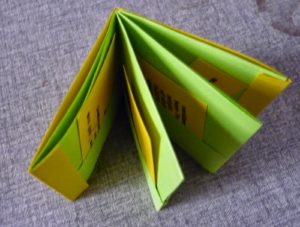Genevieve Kaplan: Exactly How Many Hats Can One Woman Wear?
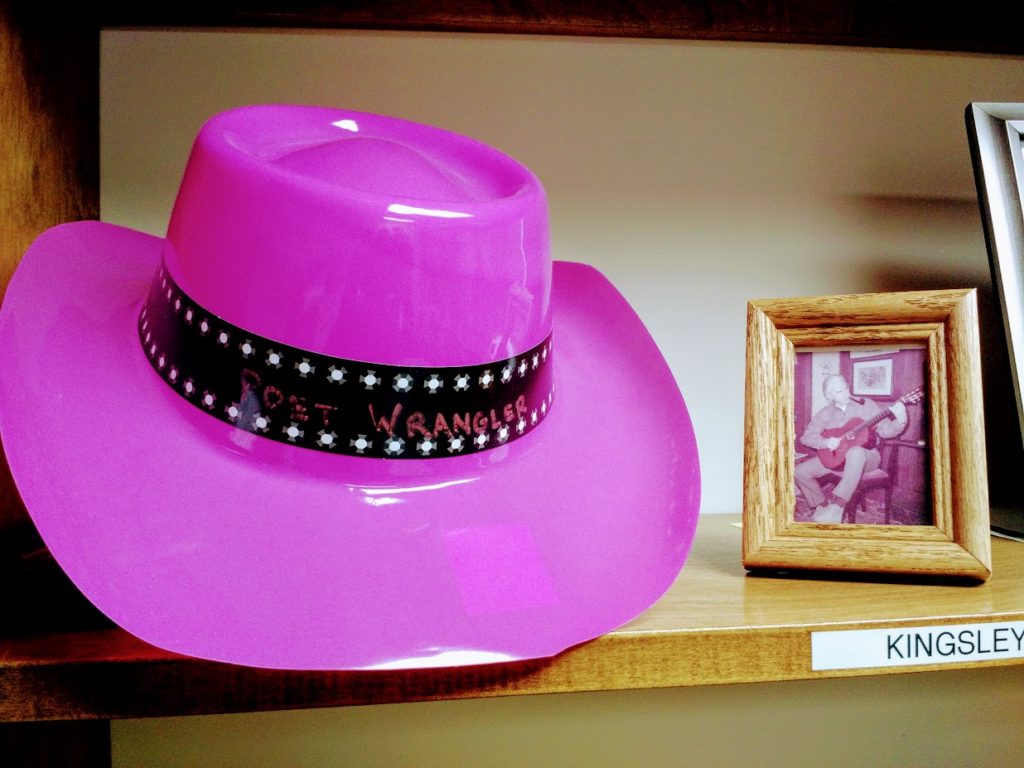
She is a scholar, professor, poet, publisher, and arts administrator – Genevieve Kaplan earned her MFA in poetry from the Iowa Writer’s Workshop and a PhD in Literature and Creative Writing from the University of Southern California, and currently teaches courses in the Writing Program at Scripps College. She is also a dedicated member of various poetic communities – co-founder of the Toad International Chapbook Series, dedicated to publishing “exciting, beautiful, odd, and avant-garde…translations,” Kaplan somehow also finds the time to be a board member for the Fourth Sundays: Poetry at the Claremont Library organization, a community-based poetry group that sponsors open-to-the-public poetry readings featuring an inclusive and wide array of poetic voices.
I am very fortunate to know Genevieve through her work as Claremont Graduate University’s Tufts Poetry Awards Coordinator, a role she has been successfully defining and occupying for the past few years. According to current Tufts Director Lori Anne Ferrell, Kaplan is an essential part of the Kingsley and Kate Tufts team: “Vieve is our finger on the pulse of the poetry community – in Claremont, L.A., California, and beyond. Her guidance and wise judgment are indispensible.” Highly collaborative and creative, extremely tireless and humble, Kaplan has proved to be my favorite type of person – those who eschew the spotlight in an effort to get the true work accomplished. I had to convince her that she was even blog worthy when, without question, she has given a tremendous amount of her time and energy to ensure that the Kingsley & Kate Tufts Awards thrive.
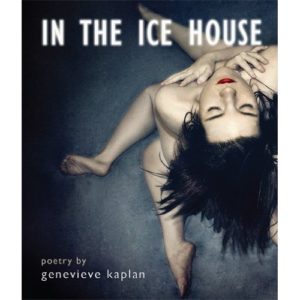
And as if this wasn’t enough already, Genevieve Kaplan is additionally an intriguingly innovative and award-winning poet. In 2009, she published a limited edition electronic chapbook entitled We’ve hardly slept or At least not all at once. Her successive poetry collection In the ice house (2011) won the A Room of Her Own Foundation’s To the Lighthouse Poetry Publication Prize and is filled with deftly detached observations and tiny echoes of the subtle yet sublime messages found in the quotidian. Throughout the work, several similarly titled entries form poetic strands that explore recurring themes of the connected domesticity and wildness of the natural world and human nature. The various incarnations of “the ice storm,” “the landscape,” “the forest and the trees,” “the birds,” and “in the kitchen” give the collection a confounding cohesion and quiet resonance.
Kaplan’s later chapbooks demonstrate an increasing sense of poetic experimentation. In settings for these scenes (2013), as A Room of Her Own alum she fittingly creates a series of erasures from a single paragraph of Virginia Woolf’s To the Lighthouse. As evidenced below, what the poet cuts away transforms Woolf’s work into something indebted yet original, creating excitingly fresh verse with antique roots:

Her latest chapbook, In an aviary (2016), features 18 verses inspired by both Mina Loy’s prose poem “Ladies in an Aviary” and Kaplan’s visits to local arboretums and botanical gardens. In an essay at Opon, the poet explains her choice of generative text:
“‘Ladies in an Aviary’ leaped onto my desk to suggest itself as an organizing principle, a happy coincidence, a difficult imagination, a devastating image. Loy’s description of women… posing as prize birds inside a cage, watched by onlookers, and waiting for men to select and adorn them…resonated with themes of enclosure and identification with the natural world that had been recently echoing through my work.”

Throughout In an aviary, Kaplan employs two major methods of incorporating Loy’s language into her chapbook collection, extending her adaptive poetic approach beyond mere erasure. For wholly new pieces, Loy’s lifted lines become titles and sources of tonal guidance. For other entries in the series the poet employs collage-style “methods of repetition and variation, curated omission, and visual erasure procedures.”
The results of both styles of Kaplan’s poetic adaptation are often startling in their disturbed sense of captured beauty. Take for instance the opening lines of the lifted-title poem “They are so lovely and they cannot get out”: “similarly, the light fades, thickens, and the moon / twice as big. if there are bars, if the key is lost / the sky is not affected. (this, a world where women / watch women, there are cages, creatures).” Or instead consider the collage-styled snippet “they are so lovely and / their breasts are pouting among / the azaleas. Dispelling shadows…who brings sugar – it is / so sweet / they inquire while their fingers / shift up and down / and this lump of sugar / burns.” Through Kaplan’s capable poetic treatment, even simple repetition of Loy’s words becomes evocative when adequately contextualized: “sugar, sugar, sugar / sugar.”
Due to the fact that Loy’s “Ladies in an Aviary” is itself the product of collage, Kaplan states that her “work in the In an aviary series is essentially that of un-collaging and/or re-collaging a poem that was only ever a collage.” And she wholeheartedly encourages other creators to engage in similar wordplay: “you can create new poems, collages, ephemeras, aviaries.”
Most recently, Genevieve has been revisiting the realm of book art, reinvestigating the impact of the physicality of the book itself upon the poetry that it contains. “I have a background in letterpress printing, weaving, book arts,” Kaplan explains about this return to focus on form:
“[but] for most of my poetic career I have focused on a more traditional poetics of-the-page (of the 8 1/5 by 11 printer page, to be more specific). Recently, I fell into a bit of writers-block-funk, and I returned to some of my book-arts techniques as a way to escape [;]…my aim wasn’t to make books, but to really think about the creation of the artist’s book as an extension of and complement to my drafting process.”
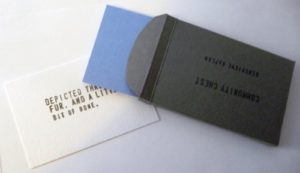 Imagine green accordion-folded poem-scapes with index-sized pockets for easy poetic rearrangement: “these little green books…allowed me to enter a different compositional framework.” Envision a cardboard “community chest” project with transferable poetic parts: “The most important things about them for me, at the time of their creation, was the sense of playfulness and experimentation, as well as the fact of their physical work—measuring, cutting, arranging, pressing the noisy keys of the typewriter keyboard.” These later experiments in form/composition underscore Kaplan’s commitment to the poetic potentials of physicality: “I’m interested in knowing when a poem and its visual counterpart add to each other or can be experienced separately.”
Imagine green accordion-folded poem-scapes with index-sized pockets for easy poetic rearrangement: “these little green books…allowed me to enter a different compositional framework.” Envision a cardboard “community chest” project with transferable poetic parts: “The most important things about them for me, at the time of their creation, was the sense of playfulness and experimentation, as well as the fact of their physical work—measuring, cutting, arranging, pressing the noisy keys of the typewriter keyboard.” These later experiments in form/composition underscore Kaplan’s commitment to the poetic potentials of physicality: “I’m interested in knowing when a poem and its visual counterpart add to each other or can be experienced separately.”
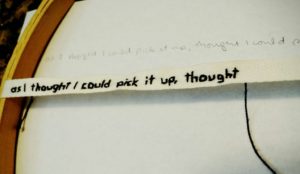
Further evidence of Genevieve’s dedication to the impact of poetry’s physicality on composition is found in her ongoing, poem-textile project: “I first write out a line of poetry by hand. Then, I sew the letters of my poem on a ribbon to form words and phrases, and then I weave the ribbons together to create the poem.” Through this purposefully slowed methodology of stitched poetry, Kaplan hopes to investigate “the creation of the poem as a worthwhile labor-intensive pursuit…the sewing time becomes a time to allow myself to think and reflect.” When weaving the poem methodically together in this almost glacial fashion, the lengthy duration between each word has its own meaning.
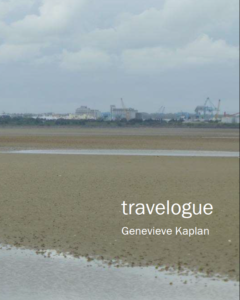
What else is there really left to say? Probably plenty when it comes to this extremely active figure. In fact, as I was feverishly editing this blog I received online word of a new Kaplan chapbook. Now available from Dancing Girl Press & Studio, travelogue is a single, lengthy poem centering on Bloomsday events in Dublin that celebrate James Joyce and the protagonist of his cornerstone novel Ulysses.
Scholar. Teacher. Publisher. Board Member. Coordinator. Poet. To be perfectly and perhaps informally honest, in my cellphone contact list and often in my email salutations when corresponding with this complex individual, Genevieve Kaplan simply becomes “Superboss.” It’s a convenient and all-encompassing umbrella that allows me to clumsily acknowledge the amazingly multifaceted talents, activities, and output of this incredible person.
—Brock Rustin
Share
